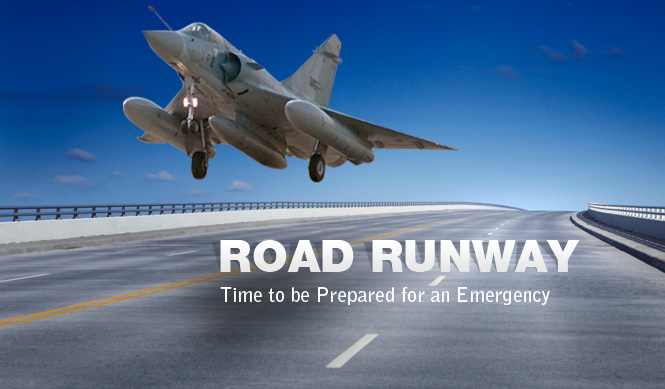 On 21 May 2015, for the first time, the Indian Air Force successfully landed a Mirage 2000 fighter jet on the Yamuna Expressway, near Mathura. So why was the Indian Air Force forced to land a fighter on an expressway? Well, it was not a forced but a strategic decision to carry out an exercise as a first step towards using an existing road network as an alternate landing and take-off facility for military aircraft during emergency situations.
On 21 May 2015, for the first time, the Indian Air Force successfully landed a Mirage 2000 fighter jet on the Yamuna Expressway, near Mathura. So why was the Indian Air Force forced to land a fighter on an expressway? Well, it was not a forced but a strategic decision to carry out an exercise as a first step towards using an existing road network as an alternate landing and take-off facility for military aircraft during emergency situations.
Threat to infrastructure from an aerial attack during war
Once a full blown war is declared, the first target for offensive attack by the enemy is to bomb and destroy the runways so that our Air Force is unable to respond with our fighters taking to the air. During the war with Pakistan in 1971, the enemy launched pre-emptive air strikes on the evening of 3 December 1971, code named ‘Operation Chengiz Khan’, and aerial bombed Indian air bases at Pathankot, Amritsar, Ambala, Agra, Sirsa, Uttarlai, Jaisalmer, Jodhpur and Jamnagar. Their aim was to destroy our runways as also our radars. Though the objective met with limited success only, as most runways became operational in a few hours, the lesson learnt was that in case of conflict, it’s prudent to have alternate infrastructure available for military aircraft to land and take-off.
The importance of developing road runways
In keeping with this, the Indian Air Force has been preparing a strategic back-up option for some time. Earlier, India did not have the requisite network of highways that could possibly be used as a back-up runway, however, the landing on the Yamuna Expressway by a Mirage 2000 fighter, has demonstrated that India has now put in place a long-term plan to develop India’s vast and still emerging network of expressways in a manner to facilitate military landing and take-off during emergency.
Agra Lucknow Expressway to be India’s first planned road runway
The Central government, along with the State government, has initiated developing the 308 km Greenfield expressway project to connect Lucknow with Agra. The proposed expressway will pass through Firozabad, Shikohabad, Mainpuri, Etawah, Kannauj, Mohanlalganj and culminating at Agra.
The project holds strategic importance as it touches Agra, an important Air Force Base and also Lucknow that can serve as an alternate to both Lucknow and Gorakhpur airfields. With this in mind, the Indian Air Force has recently proposed to the UP government to develop the Agra Lucknow Expressway in a manner wherein parts of it can serve as an alternate landing strip for military aircraft. The Indian Air Force has offered to fund this section(s) of the expressway.
Pre-requisites for a road runway
In order for a road to serve as a runway it must be completely straight and without slope for at least 3 kms. It must also be at least 50 metres wide and must not have any electric poles, lighting poles, telecom towers or any other obstruction like trees etc, in the vicinity of the stretch that will serve as a runway. The surface has to be of special and durable material to withstand regular wear and tear and still remain suitable at any time to enable an aircraft to take-off or land. Care has to be taken in installing portable road dividers that can be rapidly removed and re-installed, along with portable ground lighting, to enable aircraft to be guided during emergency.
With India’s vast network of Expressway still to be constructed, it will be strategically prudent for various state governments to cooperate with the Central government and the Indian Air Force, to plan similar stretches across India. Beyond military implications, these can also serve as important landing spaces in times of civilian emergencies where disaster relief is a priority. Strategic airlift aircraft like the C17 Globemaster that can take-off and land on short airstrips, can be very useful in such times, either to evacuate people or bring in much needed medical and other emergency aid.
All stakeholders will need to come together in national interest
While such planning and back-up procedures are important, it is equally important for all stakeholders, including the people who use the expressways, to understand that there will be times when the roads have to be temporarily shut and that some amount of inconvenience will be caused during such times.
All it takes is one unfortunate air incident on one of these road runways and we will have the media and various political parties debating their lungs out on television and various forums, on why the Air Force should conduct such exercises in civilian areas and in civilian times. But then an emergency does not strike with a warning, as the flooding in Kedarnath and Srinagar showed, and more recently, the earthquake in Nepal. In all cases, it was the military that sprung into action as the first responders in providing relief and evacuation services.
Time to optimise our infrastructure
India has already earned respect within the international community in providing emergency relief and evacuation services in Yemen and Nepal. It is now time that we be prepared in our own country for any emergency, civilian or military, and optimise the use of all available resources, including using our expressways as runways, as any military officer will tell you that the time to prepare for an emergency is during peace and not when at war.
Read More:
Traffic Signs and Road Safety in India
Stop! Says The Red Light
Worst road accidents in India
Road Rage in Delhi: Keep Your Cool, Avoid the anti-Socials
India’s Tourism Sector: Achievements and the Road Ahead
Traffic Congestion in Delhi: Causes, Outcomes and Solutions
How to keep yourself entertained during long road trips?
List of Major Rail Accidents in india




